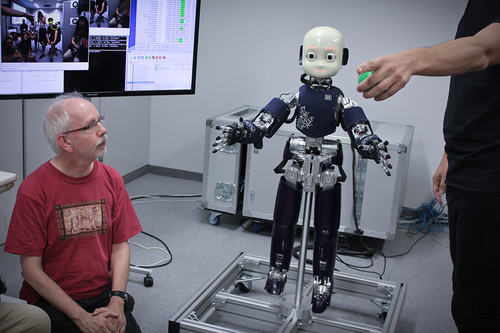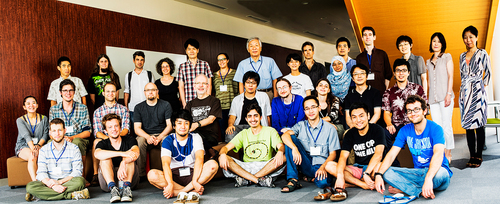ELSI Blog
110 A Summer School on the Scientific Study of Consciousness
1. An Unusual Experiment
Last week we concluded a rather unusual experiment, unusual in at least four ways, in the form of a summer school. First of all, the main topic, consciousness, was unusual. When I was a student, running an academic summer school on consciousness studies would have been inconceivable. Brain studies, artificial intelligence, psychology, all of that was fine, as long as those topics were approached from an objective, third-person point of view. But talk about first-person experience, and the relationship with third-person observations, were definitely off limits. Only recently has there been a growing recognition that both points of view are empirical, and ultimately inter-subjective.
Second, the range of disciplines from which we approached a study of consciousness was unusually broad, covering neuroscience, artificial intelligence and robotics, cognitive psychology, developmental psychology, animal studies, philosophy, as well as aspects of computer simulations and high performance computing, and applied mathematics and physics.
Third, the style was unusual. Typically, in a summer school teachers teach and students listen. Instead, in our case, all were equally involved. For a small fraction of the time, the more senior researchers would give some lectures, but most of the time was used in discussions and collaborative research projects. In that sense, the atmosphere was more like that of an active workshop rather than a typical school setting.
Fourth, the duration, three weeks, was longer than most summer schools, which typically last only one or two weeks. I will comment on this choice of duration toward the end of this blog piece. For general background and for the program see the summer school web site, where the name ISSA, Initiative for a Synthesis in Studies of Awareness, is introduced, as the organization that designed and ran the school.
The summer school was hosted by CPS, the Center for Planetary Science, in Kobe, the same place where we held our MOL (Modeling Origins of Life) workshop last year. In additions to the lectures, discussions, and the joint research sessions, we had a one-day tour along robotics labs and neuroscience labs at Osaka University, as well as a tour of the K Computer, next door to CPS, one of the fastest computers in the world. The summer school was make possible by a wide variety of generous contributions, from ELSI, EON, AICS, a Kakenhi grant, and from CPS making the space available.
 A visit to Yukie Nagai's robotic lab at Osaka University (photo by Liza Solomonova)
A visit to Yukie Nagai's robotic lab at Osaka University (photo by Liza Solomonova)
2. Connections with ELSI
There are at least two connections between the study of consciousness, including the origins of consciousness, and the study of origins of life, one of ELSI's two pillars. The first one is the context of the question of origins of life. We can ask ourselves what the most important questions are in all of natural science. Or, from a somewhat different angle, we can ask what the biggest surprises are in the history of the Universe, as we know it. In terms of important questions, an obvious set of three offers itself: 1) the origin of the Universe; 2) the origin of life; 3) the origin of consciousness.
In terms of surprises: 1) seemingly starting from nothing, what a surprise that the Big Bang seems to have produced a universe of matter and energy in space and time! 2) given that we have matter, what a surprise that some of it spontaneously organized itself in the so very intricate and unlikely patterns of living matter! 3) given that we have life, what a surprise that the complicated information processing that is present in living systems to various degrees is accompanied with our first-person subjective experience of self-awareness called consciousness -- within which everything we know and experience unfolds.
The second connection with ELSI's research is given through the shared overlap with complex systems studies. The origins of life, on a very concrete level, must be rooted in transitions from geochemistry to biochemistry. But in which way, in what kinds of surroundings, and through which intricate pattern of intermediate structures and processes, is still largely a mystery. Therefore, it makes sense to tackle this question not only through laboratory experiments and detailed theoretical models, but also to make comparisons with other forms of emergence of complex systems. Examples are the origins of major transitions in life, such as the appearance of eukaryotes and multicellularity and social species of animals, each one almost equally amazing as the origins of life itself.
And we can go further. In the cultural sphere, the appearance of language, writing, economy, agriculture and the rise of cities and states, all of those have essential properties in common with the rise of any type of qualitatively new form of complexity. Very briefly, complex systems of any type face the challenge of having to be resilient, being able to repair errors that necessarily sneak into any system of sufficient complexity. This in turn seems to require hierarchy and modularity, and for sufficient complexity, forms of digitality -- it is no coincidence that cells and humans both invented a writing system.
Given these common properties, it makes sense to look for other biological systems of very high complexity, to get more guidance as to the nature of complex systems. And the obvious example is the most complex system that we know of: the human brain. This in itself is a reason to compare the origins of life and the origins of brains. (Note: some may argue that the biosphere as a whole is the most complex system that we know. It is certainly the largest, with the largest number of components, but it lacks the kind of centralized hierarchical integration that a brain has)
3. Connection with EON
During the second week of the summer school, the last three days also functioned as the first EON workshop, titled "The Spontaneous Emergence of Autonomous Agents in Complex Systems", echoing the second connection with ELSI, described above. The first two lectures in that workshop were given by Giovanna Colombetti, from Exeter University, titled "The embodied mind" and "Philosophy and emotions". The next two days ELSI researchers lectured. The second day saw Nathaniel Virgo talking on "Towards an enactive origin of life" and Nicholas Guttenberg on "Collective effects and the emergence of robust behavior". The third day Eric gave two talks on Biogenesis. The first on "The planetary context for questions about the origin of life", followed by "Error and robustness; individuals and ecosystems: the place of autonomous agents in the biosphere."
During these three days we used the same format that we started the summer school with: lectures in the morning, and breakout discussion groups of typically four students per group in the afternoon, followed by a plenary discussion. One thing that stood out was the remarkably smooth connection between the first two lectures, with both Giovanna and Nathaniel talking about enactment, Giovanna from a philosophy background and Nathaniel from a computer science / complex systems background. Another thing that struck me was the remarkable clarity of the lectures given by Nathaniel, Nicholas and Eric: I hope that they will repeat their talks at ELSI itself in seminar form, before too long!
4. A Grass Roots ISSA Community
Throughout the three weeks, it was remarkable how involved all the students and postdocs were, excited about the opportunity to talk and work with fellow students and postdocs from totally different disciplines. As many told me toward the end, during the first week they were mostly intrigued about the different approaches taken by, say, philosophers and more empirically oriented researchers. But by the second week, they naturally began to understand each other's way of talking and thinking more, and by the third week they were ready to write actual research proposals together, as an exercise to express the knowledge they had acquired in the first two weeks.
The time it takes for people with completely different backgrounds to learn to work together, was the main reason to let the summer school run for three weeks, and also to make attendance for three weeks obligatory. We did not want people to come and go in the middle of the summer school, which would disrupt the process of community building among the participants. And this process was indeed successful: on the very last day of the summer school, we spent several hours planning follow-up activities, as a grass roots continuity of what had been accomplished in the last three weeks.
Some examples:
- continued use of a mailing list for all participants
- facebook and twitter presence
- the design of an ISSA logo
- a web site with a blog and forum, for ongoing discussions
- portal functions on that web site, such as lists of related conferences and workshops in consciousness studies in many different fields
- local follow-up meetings in Japan and elsewhere
- special ISSA sessions at future major conferences
- popular outreach, for example targeted at Japanese high school students
- a monthly journal club, about review papers in very different disciplines
- coordination of writing joint papers stemming from the summer school
This was the most gratifying outcome of the summer school, that the energy and creativity that emerged in these three weeks will be further nurtured and cultivated through all these channels, over the months and years to come.












